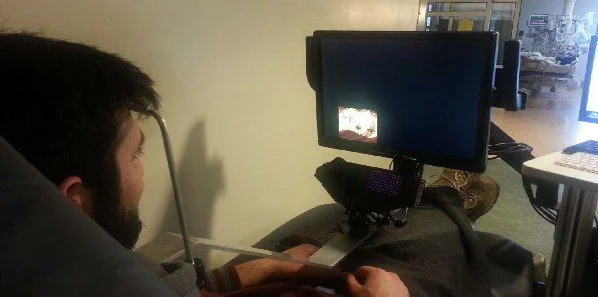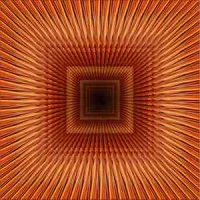A novel eye-tracking device has enabled researchers at NYU Langone Medical Center to effectively measure the severity of concussion or brain injury in patients following head trauma. They say this unique, simple and objective diagnostic tool for concussion can be utilised in the emergency room or, one day, on the sidelines at sporting events.
"Our new eye-tracking methodology may be the missing piece to help better diagnose concussion severity, enable testing of diagnostics and therapeutics, and help assess recovery, such as when a patient can safely return to work following a head injury," said lead researcher Uzma Samadani, MD, PhD, assistant professor in the Departments of Neurosurgery, Psychiatry, Neuroscience and Physiology at NYU Langone. The study is published online in Journal of Neurotrauma.
The eyes serve as a window into the brain, with disconjugate eye movements (eyes rotating in opposite directions) considered a principal marker for head trauma. Current estimates by optometrists suggest that up to 90 percent of patients with concussions or blast injuries exhibit dysfunction in their eye movements.
Unfortunately, the "state-of-the-art" tool to detect eye conjugacy is asking a patient to follow along with a physician’s finger, Dr. Samadani, who also serves as co-director of the Steven & Alexandra Cohen Veterans Center for the Study of Post-Traumatic Stress and Traumatic Brain Injury at NYU Langone. The eye-tracking device used in this study was originally developed by Dr. Samadani and colleagues at the Cohen Veterans Center to examine eye movement in veterans of the Middle East conflicts suspected of suffering from traumatic brain injury (TBI), concussion or other forms of brain injury.
The new study compared 64 healthy control subjects to 75 patients who had experienced trauma that brought them to the emergency department at Bellevue Hospital Center in New York City, with whom the NYU School of Medicine has an affiliation agreement. All participants were between 18 and 60 years of age. Researchers tracked and compared the movements of patients’ pupils for over 200 seconds while watching a music video. Key findings of the study include:
This new study of non-military, civilian trauma patients visiting the emergency department builds on recent research conducted by Dr. Samadani, supported through the Cohen Veterans Center, which showed that the use of this novel eye-tracking tool could reveal oedema or swelling in the brain as a potential biomarker for assessing brain function and monitoring recovery in people with head injuries.
The Centers for Disease Control and Prevention has said that about 2.5 million U.S. emergency department visits were associated with traumatic brain injury in 2010, with rates increasing by about 70 percent over the previous decade. At present, there is no tool seen as a gold standard for diagnosing concussions, and imaging tests like MRIs and CT-scans are ineffective in the absence of structural damage to the brain.
"Two patients who suffer a head injury and present with virtually-identical CT-scans might have completely different symptoms," Dr. Samadani pointed out. "That’s where eye-tracking can help objectively reveal when one patient may be much more affected by a concussion than another."
Dr. Samadani’s research has gained support from other experts in the medical field, including M. Sean Grady, MD, the Charles Harrison Frazier Professor and Chairman of the Department of Neurosurgery at the Perelman School of Medicine at the University of Pennsylvania.
"The importance of this study is that it establishes a reliable test and a 'biological' marker for detecting concussion," said Dr. Grady. "Since concussion can occur without loss of consciousness, this can be particularly important in sideline evaluations in athletics or in military settings where individuals are highly motivated to return to activity and may minimise their symptoms. More work is needed to establish its sensitivity and specificity, but it is very promising." Dr. Grady was not involved in the research.
Source: NYU Langone Medical Center
Image Credit: NYU Langone Medical Center
"Our new eye-tracking methodology may be the missing piece to help better diagnose concussion severity, enable testing of diagnostics and therapeutics, and help assess recovery, such as when a patient can safely return to work following a head injury," said lead researcher Uzma Samadani, MD, PhD, assistant professor in the Departments of Neurosurgery, Psychiatry, Neuroscience and Physiology at NYU Langone. The study is published online in Journal of Neurotrauma.
The eyes serve as a window into the brain, with disconjugate eye movements (eyes rotating in opposite directions) considered a principal marker for head trauma. Current estimates by optometrists suggest that up to 90 percent of patients with concussions or blast injuries exhibit dysfunction in their eye movements.
Unfortunately, the "state-of-the-art" tool to detect eye conjugacy is asking a patient to follow along with a physician’s finger, Dr. Samadani, who also serves as co-director of the Steven & Alexandra Cohen Veterans Center for the Study of Post-Traumatic Stress and Traumatic Brain Injury at NYU Langone. The eye-tracking device used in this study was originally developed by Dr. Samadani and colleagues at the Cohen Veterans Center to examine eye movement in veterans of the Middle East conflicts suspected of suffering from traumatic brain injury (TBI), concussion or other forms of brain injury.
The new study compared 64 healthy control subjects to 75 patients who had experienced trauma that brought them to the emergency department at Bellevue Hospital Center in New York City, with whom the NYU School of Medicine has an affiliation agreement. All participants were between 18 and 60 years of age. Researchers tracked and compared the movements of patients’ pupils for over 200 seconds while watching a music video. Key findings of the study include:
- 13 trauma patients who had hit their heads and had CT scans showing new brain damage, as well as 39 trauma patients who had hit their heads and had normal CT scans, had significantly less ability to coordinate their eye movements than normal, uninjured control subjects.
- 23 trauma subjects who had bodily or extremity injuries but did not require head CT scans had similar abilities to coordinate eye movements as normal uninjured controls.
- Of the 39 patients who had hit their heads and had normal CT scans, most were slightly worse at 1-2 weeks after the injury, and subsequently recovered about one month after the injury.
- Amongst all trauma patients, the severity of concussive symptoms correlated with severity of disconjugacy.
This new study of non-military, civilian trauma patients visiting the emergency department builds on recent research conducted by Dr. Samadani, supported through the Cohen Veterans Center, which showed that the use of this novel eye-tracking tool could reveal oedema or swelling in the brain as a potential biomarker for assessing brain function and monitoring recovery in people with head injuries.
The Centers for Disease Control and Prevention has said that about 2.5 million U.S. emergency department visits were associated with traumatic brain injury in 2010, with rates increasing by about 70 percent over the previous decade. At present, there is no tool seen as a gold standard for diagnosing concussions, and imaging tests like MRIs and CT-scans are ineffective in the absence of structural damage to the brain.
"Two patients who suffer a head injury and present with virtually-identical CT-scans might have completely different symptoms," Dr. Samadani pointed out. "That’s where eye-tracking can help objectively reveal when one patient may be much more affected by a concussion than another."
Dr. Samadani’s research has gained support from other experts in the medical field, including M. Sean Grady, MD, the Charles Harrison Frazier Professor and Chairman of the Department of Neurosurgery at the Perelman School of Medicine at the University of Pennsylvania.
"The importance of this study is that it establishes a reliable test and a 'biological' marker for detecting concussion," said Dr. Grady. "Since concussion can occur without loss of consciousness, this can be particularly important in sideline evaluations in athletics or in military settings where individuals are highly motivated to return to activity and may minimise their symptoms. More work is needed to establish its sensitivity and specificity, but it is very promising." Dr. Grady was not involved in the research.
Source: NYU Langone Medical Center
Image Credit: NYU Langone Medical Center
Latest Articles
trauma, Concussion, CT scans, eye, brain injuries, eye-tracking device
A novel eye-tracking device has enabled researchers at NYU Langone Medical Center to effectively measure the severity of concussion or brain injury in pati...










